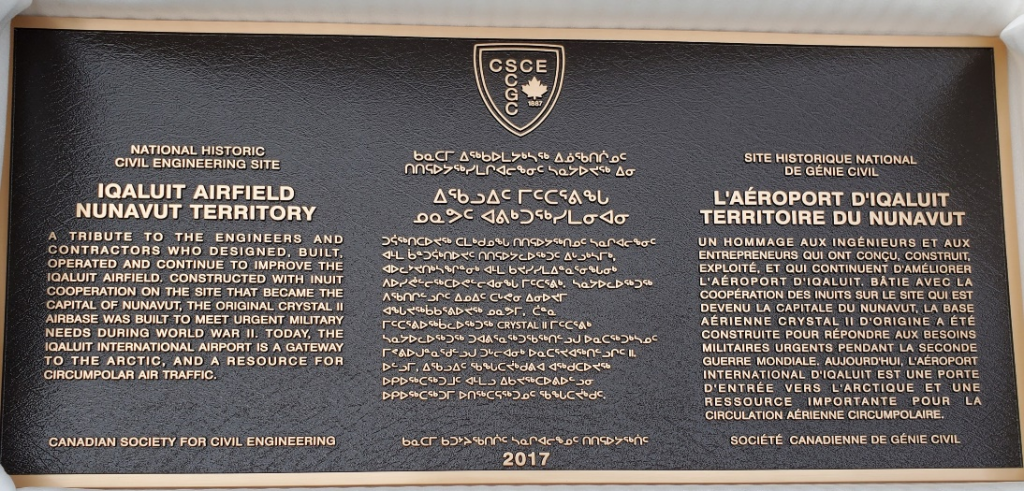
Site Location: Lat.: 63° – 45’ – 24” N.; Long.: 68° – 33’ – 22” W. (GPS: 63.756667, -68.556111). Accessible by air or by water from southern Canada.
Plaque Location: The plaque has not yet been installed, but it is anticipated that the plaque will be placed adjacent to the new airport terminal.

Description: In 1942, the United States military constructed the Iqaluit Airfield, originally known as Crystal II, to support the ferrying of aircraft from North America to Europe. Their work at the airfield continued until 1957 when the Canadian Department of Transportation took control of the airfield, to operate it as a civilian facility, and was responsible for all subsequent construction. The Government of Canada gave the US Government $6.8 million in 1944 as compensation for the airfield construction. The field has one asphalt-surfaced runway, 2620 m (8605 ft.) long. A new terminal building opened in 2017.


Historic Significance: The Iqaluit Airfield is central to the evolution of Crystal II to Frobisher Bay (1964) and Iqaluit (1987) as the capital of Nunavut. Iqaluit joins the venerable site of Louisbourg as a strategic military and administrative hub that originated entirely from a military need instead of a commercial venture, such as a trading post.
The construction of the Iqaluit airfield made pioneering contributions to the discipline of cold regions engineering because it was the first major construction project in a Canadian region with continuous permafrost. Materials and equipment were mobilized during a narrow window of ice-free Arctic waters from 3,000 km away. The construction itself occurred in a narrow window of the Arctic summer. The original airfield terminal building, constructed in 1943, remains in use today.
Iqualuit Airfield was the back-up for transatlantic flights unable to refuel at Gander, Newfoundland due to adverse weather conditions.
Plaque Wording: CSCE. National Historic Civil Engineering Site. IQALUIT AIRFIELD NUNAVUT TERRITORY. A tribute to the engineers and contractors who designed, built, operated and continue to improve the Iqaluit Airfield. Constructed with Inuit cooperation on the site that became the capital of Nunavut, the original Crystal II airbase was built to meet urgent military needs during World War II. Today, the Iqaluit International Airport is a gateway to the Arctic, and a resource for circumpolar air traffic. Canadian Society for Civil Engineering. 2017.
SCGC. Site Historique National de Génie Civil. L’AÉROPORT D’IQALUIT TERRITOIRE DU NUNAVUT. Un homage aux ingénieurs et aux entrepreneurs qui ont conçu, construit, exploité, et qui continuent d’améliorer L’aéroport d’Iqaluit. Bâtie avec la cooperation des inuits sur le site qui est devenu la capitale du Nunavut, la base aérienne Crystal II d’origine a été construite pour répondre aux besions militaires urgents pendant la seconde guerre mondiale. Aujourd’hui, L’aéroport International d’Iqaluit est une porte d’entrée vers l’arctique et un resource importante pour la circulation aérienne circumpolaire. Société canadienne de genie civil. 2017
Links to Online Documentation:
Ken Johnson, “Crystal to Iqaluit – 75 Years of Planning Engineering and Building”, 2017 CSCE Annual Conference paper.
Steve Ducharme, “Nunavut airfield nominated for engineering history honour”, Nunatsiaq News, 2017.
Sarah Grandy, “Iqualuit airfield receives engineering honour”, Iskies, 2017.